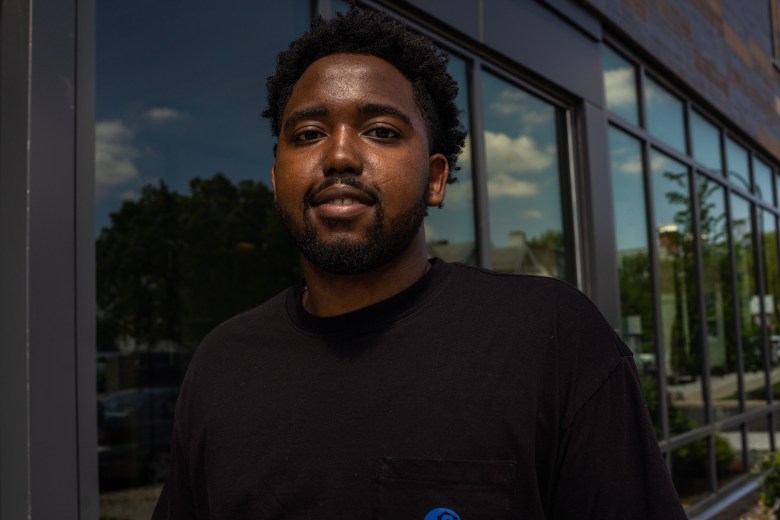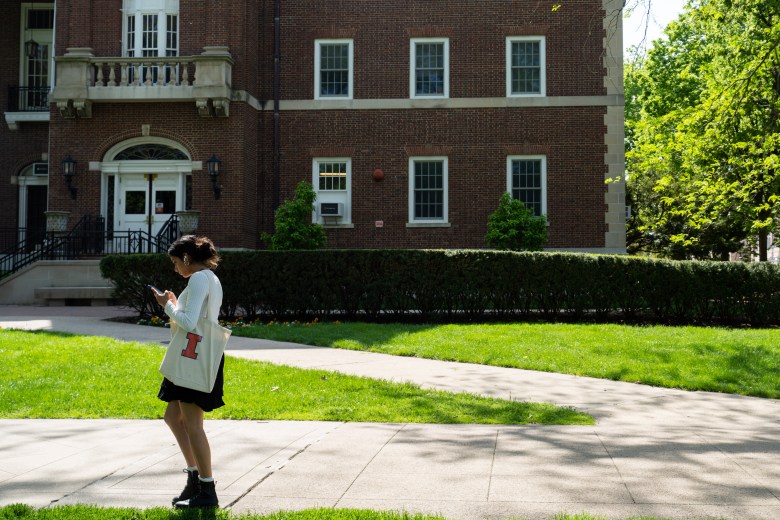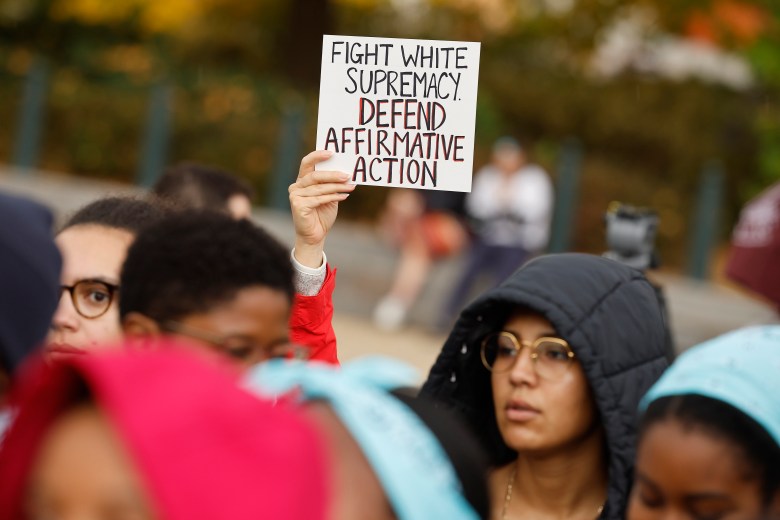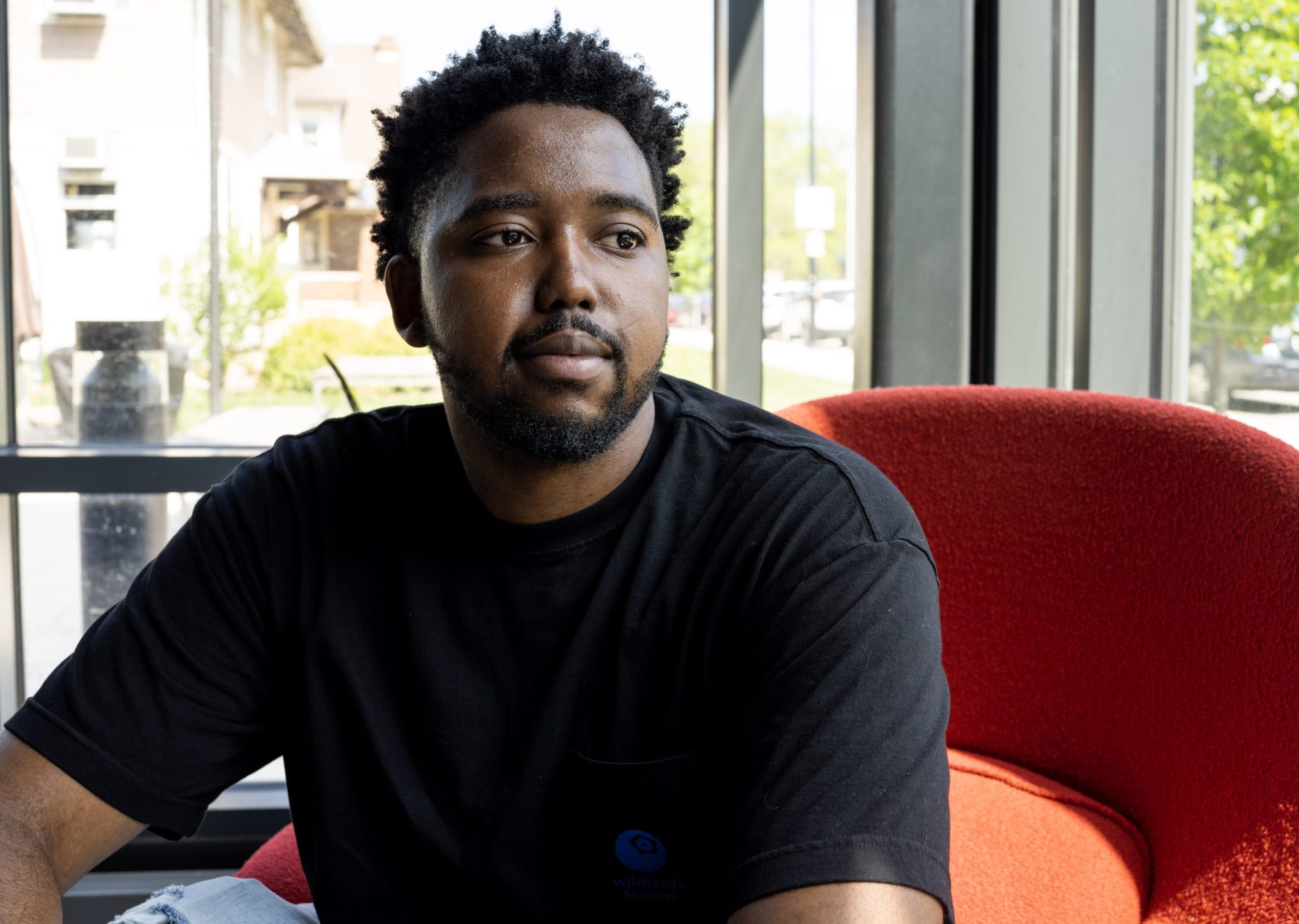Patrick Ben III always knew he’d go to college, even though his parents hadn’t.

He also knew that the high school he attended on Chicago’s South Side offered few of the advantages that wealthier kids got.
There were no Advanced Placement courses, for example, and little help was available with college and financial aid applications, said Ben, who is Black.
“I understood that a lot of the things I did to prepare for college I would have to do myself.”
When he made it to the University of Illinois at Urbana-Champaign, the shortcomings of his high school were even more evident. Other students from more affluent places “were sitting there in class talking about how they’ve already done this stuff, where I’m thinking, all of this is new to me.”
These things “just reminded me of what I already knew about the politics of education and the lack of resources in low-income communities when it comes to schools,” said Ben, now 22 and about to graduate and go back to Chicago to teach while pursuing a master’s degree.
“I can’t be mad that the opportunities are different,” he said, “because it’s out of my control. It’s just the way society is.”

As states push back against diversity programs, and the Supreme Court considers whether to eliminate affirmative action in admissions, a central question remains: whether the playing field has finally been leveled, especially between white and Black Americans who aspire to college educations and the higher quality of life they bring.
The answer? Not only has this equity divide failed to narrow — it’s getting worse.
“In a way, we’re in the worst of all possible worlds for civil rights, because people think a lot of problems have been solved,” said Gary Orfield, co-director of the Civil Rights Project at the University of California, Los Angeles.
In fact, Orfield said, “we’re not making progress. The gaps are huge, and there’s no prospect of them closing in the foreseeable future. We’re going backwards.”
Black college and university enrollment has been dropping steadily. Already down by 22 percent between 2010 and 2020, or by more than 650,000 students, according to the National Center for Education Statistics, it has fallen by another 7 percent since then, more recent figures from the National Student Clearinghouse Research Center show.
Even though the number of white students has also declined since 2010, the difference between the proportions of white students and Black students graduating with degrees has gotten bigger, data from the National Student Clearinghouse Research Center show.
Related: Beyond the Rankings: The College Welcome Guide
Thirty-four percent of Black adults have associate degrees or higher, compared to 50 percent of white adults, according to the Lumina Foundation. (Lumina is among the funders of The Hechinger Report, which produced this story.)
“There’s a facade that’s trying to be presented that everything is okay. But we never were okay, even before the pandemic,” said Wisdom Cole, national director of the NAACP youth and college division.
Many factors account for this disparity. The biggest is cost.
The average Black household earns about half as much as the average white household, and white families have eight times the median wealth of Black families — $188,200, compared to $24,100 — a gap that also has been getting wider, the Federal Reserve reports.
“We’re actually looking at projections that show we’re not going to be really closing this gap for a very long time, if ever.” Gary Orfield, co-director of the Civil Rights Project, University of California, Los Angeles
“The equalizer to close these gaps was supposed to be education. If you’re able to go to college, you’re able to find a job and support yourself and your family. But the outcomes aren’t showing that,” said Justin Nalley, senior policy analyst at the Joint Center for Political and Economic Studies, a Black think tank.
This economic disparity means that going to college, for Black Americans, is much more likely to require going into debt — and larger amounts of it. Eighty-six percent have to borrow toward a bachelor’s degree. Black students who make it to graduation end up owing nearly 50 percent more than white graduates, according to the Brookings Institution.
Related: Culture wars on campus start to affect students’ choices for college
They also go on to earn less than white graduates, which makes that obligation harder to repay.
University degree or not, “you’re facing discrimination in the workplace when it comes to hiring and when it comes to salaries,” Cole said.
The result is that “people end up with a degree, debt and a not very good job,” said Martha Snyder, a managing director at the education consulting firm HCM Strategists.
Black college and university graduates earn an average of 15 percent less than their white classmates and are more likely to be underemployed, the NAACP finds. Almost 40 percent default on their college loans within 12 years, compared to 12 percent of white graduates, The Institute for College Access and Success says.
“We’re not making progress. The gaps are huge, and there’s no prospect of them closing in the foreseeable future. We’re going backwards.”
Gary Orfield, co-director of the Civil Rights Project, University of California, Los Angeles
But the other reasons Black enrollment has been declining begin much earlier than college, with the quality of the education Black students receive in kindergarten through grade 12.
Forty-five percent of Black children go to high-poverty primary and secondary schools, compared to 8 percent of white students.
“Our high schools are more segregated than ever and prepare students very unequally,” Orfield said.
Black students are more likely than white students to be held back, disciplined or diverted into special education and less likely to have access to Advanced Placement courses, researchers at the Annenberg Institute for School Reform at Brown University have found. They attribute this to race-based socioeconomic inequality in schools.
Related: Where poor students pay more than rich ones
Black high school students who didn’t go to college or dropped out are more likely to say they want to go, or go back, than similar white students — 50 percent to 42 percent, respectively — according to focus groups convened by Edge Research and HCM Strategists for the Bill & Melinda Gates Foundation.*
Yet while 67 percent of white high school graduates went directly to college in 2020 — the most recent year for which the figure is available — 54 percent of Black high school graduates did, the National Center for Education Statistics reports. That’s down from 66 percent in 2010.
“In a way, we’re in the worst of all possible worlds for civil rights, because people think a lot of problems have been solved.”
Gary Orfield, co-director of the Civil Rights Project, University of California, Los Angeles
Results like these owe more to the wealth divide than to academic ability, a long-term federal study suggests.
The study followed 23,000 students beginning in 2009, when they were in the ninth grade. An analysis of the resulting data by the Center for American Progress found that even the highest-achieving low-income students went to college at lower rates than their more affluent counterparts. The wealthiest students with mediocre academic backgrounds were just as likely to enroll as the lowest-income students with the highest grades and test scores.
Of those who did go to college, only 7 percent of Black students ended up at a selective university, compared to 19 percent of white students. Many taxpayer-funded public flagship universities enroll a significantly lower proportion of Black students than graduate from their states’ public high schools — a gap that is also growing.
“It’s tempting to think that America has largely solved its problems surrounding access to postsecondary education,” the Center for American Progress report said. In fact, it said, the data show “that the United States still fails miserably” at this.
Financial aid can help, but eligibility rules for some of the nearly $15 billion of state-level financial aid for college often make it harder for Black students to get that aid, research by the Urban Institute has found. That’s because these programs are often based on high school academic performance, which can be affected by the varying quality of schools, and require students to attend college full time and immediately after graduating from high school, which Black students are less likely than white students to do.
Meanwhile, over the last 10 years, nearly 700 colleges and universities have raised the costs to their lowest-income students more than they’ve raised costs to their highest-income ones, according to federal data analyzed by The Hechinger Report.
Those Black students who do manage to enroll in college are less likely to finish. About 40 percent go to lower-priced but poorly funded public community colleges, which have very low completion rates. Nearly half of all public community college students drop out, within a year, of the school where they started, and only slightly more than 40 percent finish within six years.
Black students who make it to graduation end up owing 50 percent more in student loans than white graduates.
In California, nearly two-thirds of Black students who go to college start at a community college, but nearly half quit without receiving any credential, according to a study by The RP Group, a nonprofit research organization.
Black students also disproportionately attend part time. Fifteen percent are caregivers for family members, 11 percent are parents or guardians and 20 percent work full time — all about double the proportions of other students.
Fifty-six percent of Black students at four-year universities and colleges go part time at some point, versus 42 percent of white students, making it far less likely that they will graduate within six years, according to the advocacy group Complete College America.
“I can’t be mad that the opportunities are different, because it’s out of my control. It’s just the way society is.”
Patrick Ben, graduating senior, University of Illinois at Urbana-Champaign
When they are on campus, more than a fifth of Black university and college students report frequently or occasionally feeling discriminated against; of these, 61 percent have considered dropping out, a Gallup poll commissioned by Lumina and released in February found.
“Having a sense of belonging is critical, and part of what has happened in the last few years is this sort of heightening of these culture wars that create even more questioning of, ‘Do I really belong on campus?’ ” said Steve Colón, CEO of Bottom Line, which provides counseling to help Black and other marginalized students get to and through college.
Even dorms are increasingly racially segregated, a researcher at the University of Kansas has found, with higher-quality buildings that, because of their cost, are often predominantly white.
Related: How the promise of free college doesn’t always help low-income students
“If the education they’re receiving is not equitable, if they’re seeing discrimination happen on campus, segregation happening on campus — it’s not enough to just attract students to that campus, but are you retaining those students?” Cole said.
Here, too, the answer is no. Only 40 percent of Black students graduate from four-year universities and colleges within even six years, compared with 64 percent of white students, according to the National Center for Education Statistics; the rest are still struggling through or have dropped out, most of them with debt but no degree.
“We were celebrating increases in access, but never really asking ourselves, are these students graduating? And they really weren’t,” Colón said.
This leads to the reality that although only about a third of Black Americans have college and university degrees, more than half of 25- to 40-year-old Black parents heading households owe student loan debt, according to the progressive think tank Demos.

Nineteen percent of Black adults, or nearly 6.4 million, have some college credit but no degree, compared with 16 percent of white adults, the Census Bureau reports.
This creates a vicious cycle, said Keith Curry, president of Compton College, a community college in California, and part of a group of college administrators, consultants and policymakers alarmed by and trying to reverse the decline in Black enrollment.
“If a student doesn’t have a good experience, they will tell somebody else in their neighborhood,” he said. “A younger relative who hears that story isn’t going to enroll.”
For this and other reasons, experts and research suggest that these declines may speed up.
If the Supreme Court strikes down affirmative action in admissions in a decision expected by the end of June, selective colleges and universities are likely to become even less racially diverse, the Georgetown University Center on Education and the Workforce has concluded.
“We’re actually looking at projections that show we’re not going to be really closing this gap for a very long time, if ever,” said Orfield, author of “The Walls Around Opportunity: The Failure of Colorblind Policy for Higher Education.”
Related: ‘The reckoning is here’: More than a third of community college students have vanished
When California passed Proposition 209 in 1996, prohibiting public universities from considering race in admission, Black students ended up being pushed from more-selective to less-selective institutions, research at the University of California, Berkeley found.
Stripping high schools of ethnic studies courses, which some states are also doing, may take a toll, too, according to researchers at Stanford, the University of Massachusetts and the University of California, Irvine. It found that students who took an ethnic studies course in ninth grade were more likely to enroll in college.
It’s a demoralizing time, said Curry. “But also look at it this way: You’ve seen marginalized groups that have experienced racism for decades, even centuries. We’re trying to change systems and structures that have been around for decades.”

Already strapped for students, universities and colleges ignore these problems at their peril, said Nalley, of the Joint Center. “They can’t just rely on the continued resilience of Black high school students to hope to go to college. You have to remove the barriers and have some policies in place so that they can actually do that.”
Bez Burks, a junior at Illinois State University, sees visceral symbols of the equity divide when he visits a classmate who lives in a luxury apartment building near the campus.
His friend, who also has a car, enjoys a pool, a fitness center and a 2,700-square-foot suite with granite countertops, flat-screen TVs and queen-sized beds. Some of the units include hot tubs, steam showers, balconies and bistro kitchens.
Burks, who is Black and — like Ben — from Chicago’s South Side, took three buses each way, every day, to go to a charter high school away from his neighborhood. In college, he works more than 20 hours a week at Walmart to help pay for his tuition and rent for a much more modest room. His single mother, a nurse, picks up extra shifts to help, and he’s taken out loans and applied for grants from nonprofit organizations to cover the rest.
Sometimes, this reminder of the comparative obstacles he faces “really grinds my gears,” said Burks, a marketing major who hopes one day to start his own marketing firm. But “I try not to think about it too much. If I have to work twice as hard, that’s what I will do.”
*Correction: An earlier version of this story mischaracterized the types of students who were surveyed in focus groups.
This story about the college equity gap was produced by The Hechinger Report, a nonprofit, independent news organization focused on inequality and innovation in education. Sign up for our higher education newsletter.



Hello,
I am writing this letter to lend my voice to the subject of college gaps. I am retired military, I work in education, and I am a mental health professional with a passion for this subject. I do agree with the statistical data because it paints the present picture concerning black educational achievement. I am solutions-orientated with a belief that we have the power to lead the change. My belief is that we as a collective have looked too much at external locus of control and not enough at internal factors of control. The identification of Black as a race or ethnicity has reduced our ability to educate young people to command task (resource) goal orientated behavior; therefore, they are focused on success and failure. This is something we cannot control due to the fact that we do not command any production sector of control in this nation.
I appreciate much of the focus of this article; however, it follows a troubling trend that conflates and distorts data and seems to drive to a conclusion that college and spending for college or grad school is ‘not worth it for Black people.’ For example, the data point referenced from the Brookings study is quoted here as ‘black students who make it to graduation owe 50% more than in loans whites’. And the quote is called out later in the article as a talking point with no footnote. The link to the Brookings article shows that’s not accurate, and in particular that the 50% number is 4 years after graduation, and includes usage of different loan product AND grad school borrowing, which is an entirely different issue and again implies Black people shouldn’t use any loans or credit to get to the same place that higher income (white) people get to. The Brookings study also includes non borrowers, which isn’t explained in your piece. The article then implies this 50% more debt is held by Black people with lower paying jobs. But these are the folks who got grad degrees?
The reality is that due to many historic and wide ranging factors, Black students in the US are often lower income – on average – than white peers in college. So, unless financial aid or grants are more abundant, they are going to have to find funds to close the gap to get a college degree. I agree that Black and low income students should have better pathways to pay for college, but I strongly disagree that they should be discouraged to complete college – 2 year or 4 year – until it magically costs less . I fear that is the prevailing theme here.